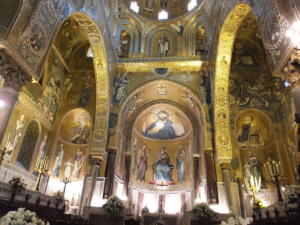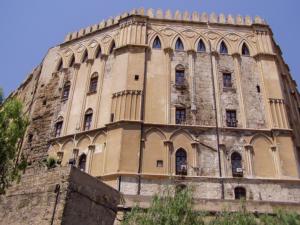
Sicily has an ancient and fascinating historical legacy. For over 2,500 years the island has been under the dominion of Phoenicians, Greeks, Romans, Byzantines, Arabs, Normans, French, Germans and Spanish. History surely left an indelible mark on Sicily that tourists can admire just strolling around Sicilian cities’ old towns.
It is fascinating how well preserved are some of the buildings and art dating back to Sicily’s ancient past. UNESCO included some of the historical buildings around the island in one itinerary listed as World Heritage along with many other UNESCO sites in Sicily: the Arab-Norman itineraries in Palermo, Monreale and Cefalù.
If you are planning a visit to the capital, Palermo, you cannot miss the chance to visit at least a couple of these landmarks, starting with Palazzo dei Normanni the seat of the Norman and German kings of Sicily.
Planning an itinerary to visit the main UNESCO sites on the island? Check out our selection of villas in Sicily near UNESCO sites.
A little history
It was the 1061 when Normans invaded Messina and a few years conquered Palermo. From the 1071 onwards, the
Normans took possession of Sicily. They were very tolerant people and the court of King Roger II was composed of Islamic soldiers, counselors, poets and scientists. The Kingdom of Sicily was characterized by a multicultural composition and even by religious and linguistic tolerance, the languages spoken at court were in fact Greek, French, Latin and Arabic. During Roger II’s reign the arts flourished: the Normans called Arab, French, Greek craftsmen and architects who gave life to majestic churches and palaces, impressive castles showing the harmony between the decorative purity of Arab ornamentation and the splendor of Greek Byzantine mosaics.

The Norman Palace in Palermo. Source: Wikipedia
Sicily’s Golden Era reached a peak in the thirteenth century during the reign of Frederick II, Emperor of the Holy Roman Empire who chose Palermo as the capital of his reign. Under his guide the Empire reached its all time territorial peak.
Arab-Norman itinerary
Norman and German era left an incredible legacy of artworks and architectural masterpieces all over the Northern coast of the island. Many of them became part of the prestigious Arab-Norman Itinerary of Palermo, Cefalù and Monreale a UNESCO World Heritage Site. The itinerary includes nine religious and civic buildings located in Northern Sicily.
Seven of them are in Palermo, such as Palazzo dei Normanni, the ancient seat of the Kingdom of Sicily that was originally an Arab castle completely renovated by the Normans who built the Palatine Chapel (also known as Norman Chapel), whose beauty got famous all over the world and keeps fascinating visitors and locals alike. It is probably the best example of the Arab-Norman style of the 12th century thanks to the Norman architecture, the elegant Arabic arches and the golden Byzantine mosaics.
Check out the Palermo section of our Sicily Travel Guide for further information, or take a look at out our Villas Deals to start planning your Sicilian getaway!
Top picture: Palatine Chapel’s mosaics. Author: Fintan Corrigan Source: Wikipedia.


